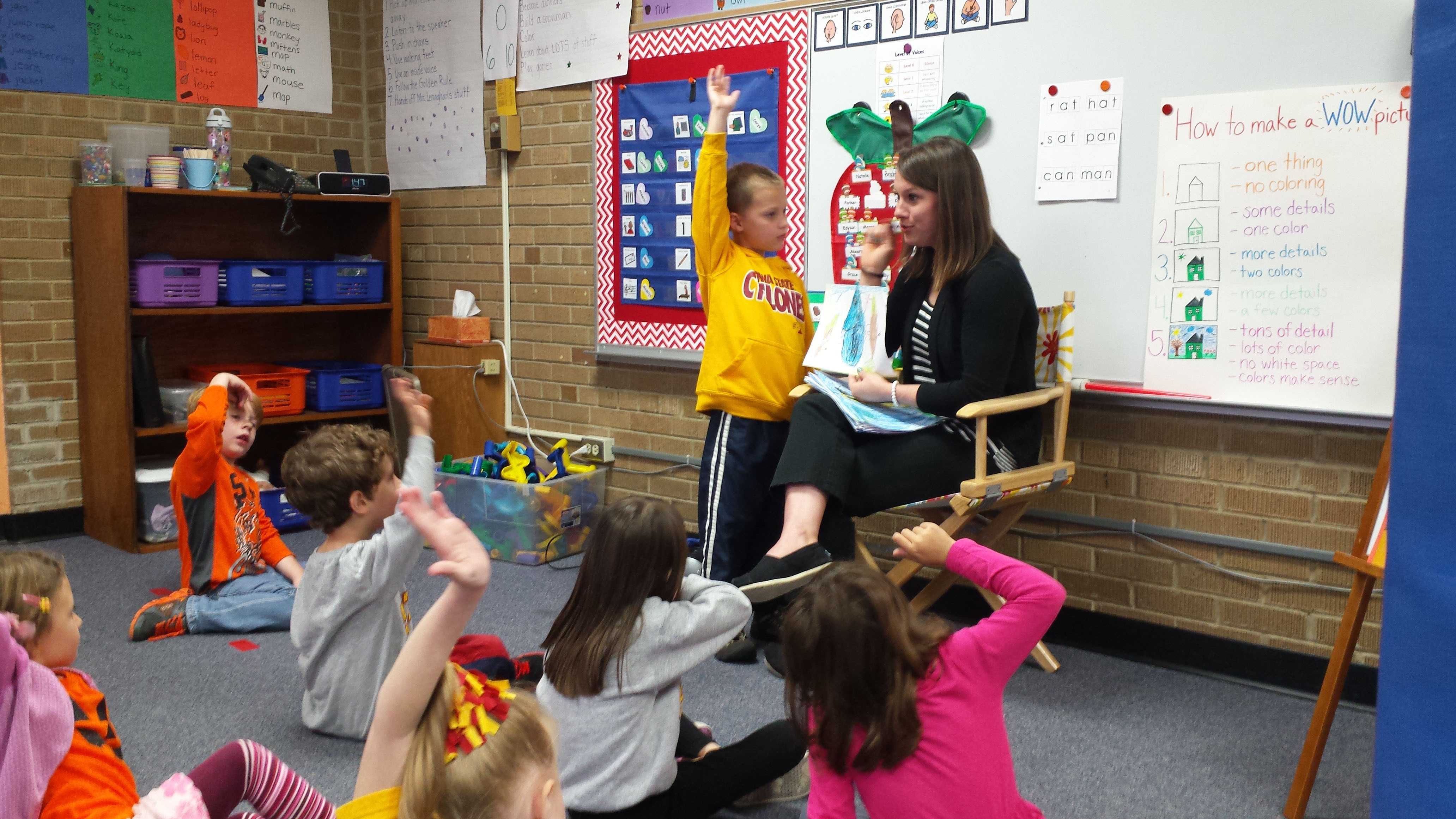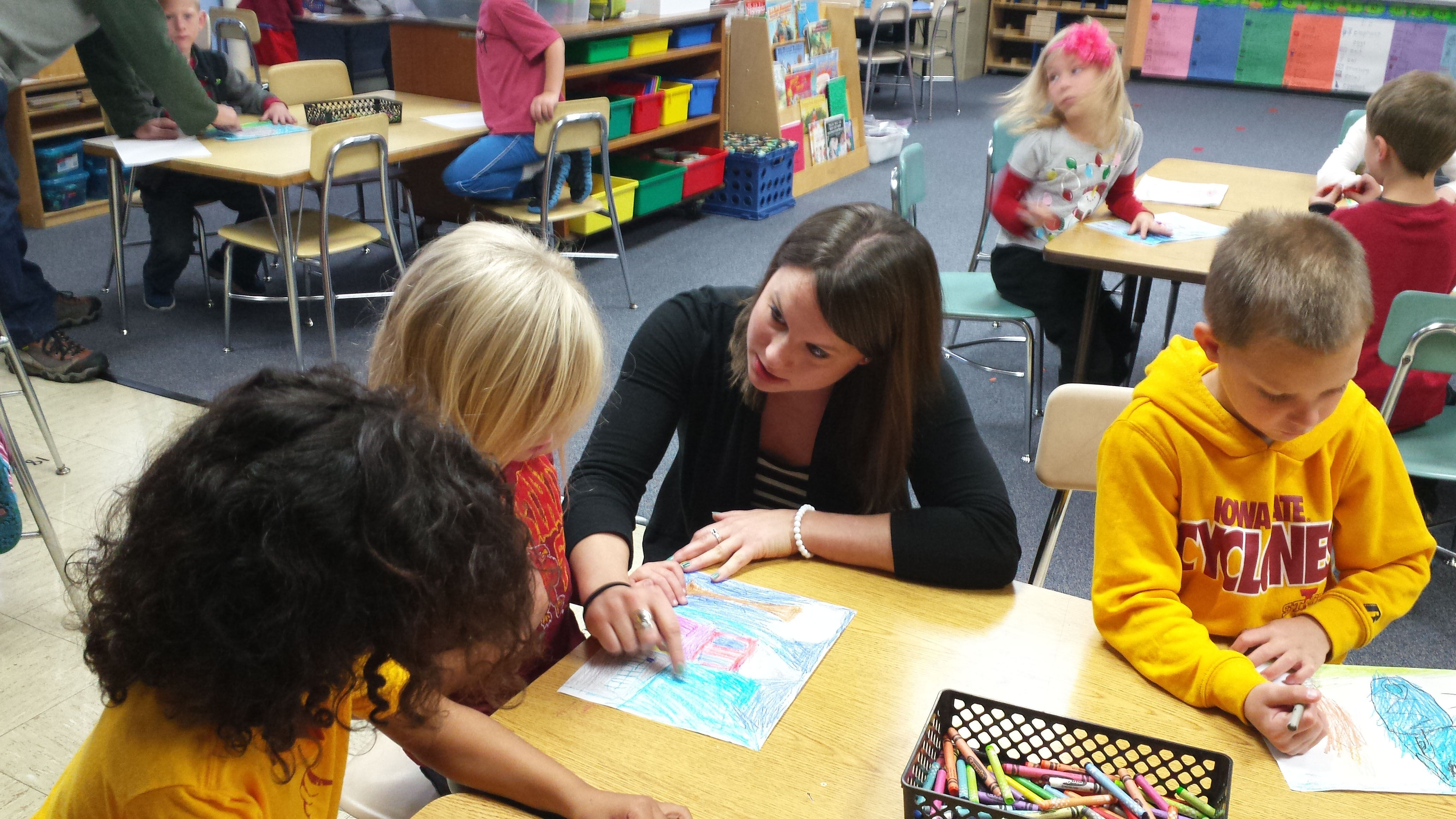
Michelle Shealy works with kindergarten students at Meeker Elementary in Ames as part of her student teaching experience. (Larger image)
AMES, Iowa – It’s fair to say that Michelle Shealy had a few nerves the first time she stood in front of a roomful of kindergarten students at Meeker Elementary in Ames and realized she was in charge. The Iowa State University elementary education major spent weeks observing in the classroom, after years of preparation on campus, and knew it was time to demonstrate her skills and knowledge.
“I knew I could do it, but I was still nervous,” Shealy said. “I had a great cooperating teacher, which really helped. And once I did my first lesson, it built my confidence and I gradually progressed and would do more and more each day. By the time I was teaching for the full day, it wasn’t such a big jump, it just seemed normal.”
That’s exactly the type of experience ISU’s Educator Preparation Program wants its student teachers to gain in the classroom. The goal is to ensure every student teacher is comfortable planning instruction, teaching and assessing, and managing other classroom needs, before they graduate, said Heidi Doellinger, director of Teacher Education Services for ISU’s School of Education.
“It’s that real-life experience prior to their first teaching job,” Doellinger said. “It’s also an opportunity for students to feel and become more competent teaching and to begin to identify if there are grade levels they prefer to teach.”
Guaranteeing students, such as Shealy, get the experience they need is no easy task. Doellinger and her staff are preparing to place a record 270 student teachers this spring in schools across Iowa and around the world. The previous high was 194 students. Approximately 95 percent opt to stay in Iowa, but others go to area districts in Kansas City, Minneapolis, Omaha, Chicago and Aldine, Texas, as well as international sites for their student teaching.
Iowa State’s Educator Preparation Program requires all elementary and early childhood student teachers complete two, eight-week sessions in two different placements. Several secondary programs have similar requirements to give students experience teaching at both the middle school and high school level. For that reason, it will take 465 different placements to accommodate all the student teachers this spring. This will include 20 international student placements, 76 placements outside of central Iowa, but in the U.S., and 369 placements in central Iowa.
Challenge with placements
All student teachers are paired with a cooperating teacher who offers guidance and serves as a coach and mentor. Iowa State has strong partnerships with many schools. However, as demand is increasing, the number of cooperating teachers is declining, Doellinger said.
Cooperating teachers generally need a minimum of three years of experience and must meet requirements set by their school district and Iowa State before they can work with a student teacher. Many of those experienced teachers are now taking advantage of the Teacher Leadership and Compensation System in Iowa, a legislative initiative that provides grants to grow leadership positions.
“A number of the teachers we used as cooperating teachers are now mentors or master teachers in their own districts,” Doellinger said. “It’s a great opportunity for teachers, but unfortunately these individuals are no longer in a position to work with our students.”

ISU’s Educator Preparation Program is working to expand its network of cooperating teachers to meet the placement needs of student teachers. Iowa State offers workshops and support as well as compensation for its cooperating teachers. Doellinger says most teachers don’t agree to be cooperating teachers because of the compensation, but rather as a way to give back and help grow the profession.
Reasons for growth
Doellinger credits several factors for the increasing demand for student teaching placements. Iowa State’s secondary education programs, with the exception of math and science, are housed in their major departments, she said. For example, a student who wants to teach high school history majors in history at Iowa State, while completing the requirements for their teacher licensure. Doellinger says this allows secondary education teachers to be true experts in those content areas.
The School of Education’s emphasis on technology, including a minor in learning technologies, is also a strong recruiting tool. As schools incorporate more technology, it is important for student teachers to be able to walk into a classroom and hit the ground running. School administrators often comment that ISU student teachers are well-prepared when it comes to technology, Doellinger said. Cooperating teachers also mention that they learn new things about technology from their student teachers.
Another strong selling point for the program – the Iowa State campus and students.
“A number of our student teachers come to Iowa State because they had a student teacher or a teacher from Iowa State when they were in high school or middle school,” Doellinger said. “Another huge draw, aside from the program, is that when students step foot on this campus they just really like it.”
Placement coordinators build a one-on-one connection with teacher candidates to make sure their student-teaching experience is a good fit and meets their long-term career goals. Teacher Education Services also supports students in completing requirements and paperwork for licensure. The fact that approximately 94 percent of ISU students who received licensure between fall 2011 and spring 2013 have placements speaks to the success of the program, Doellinger said.
